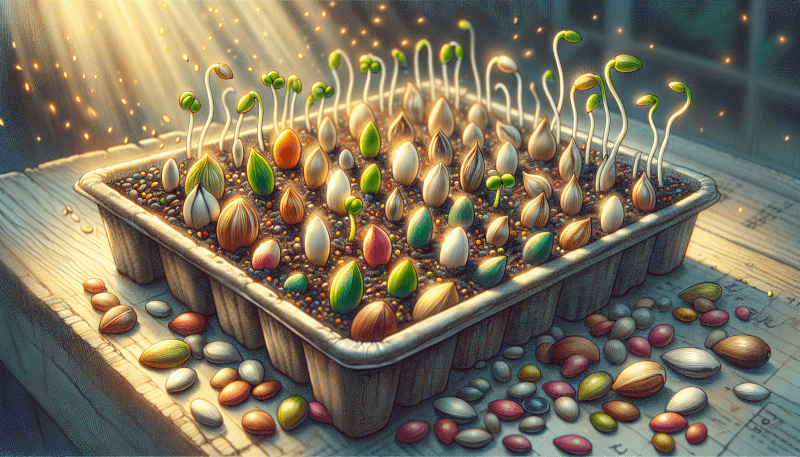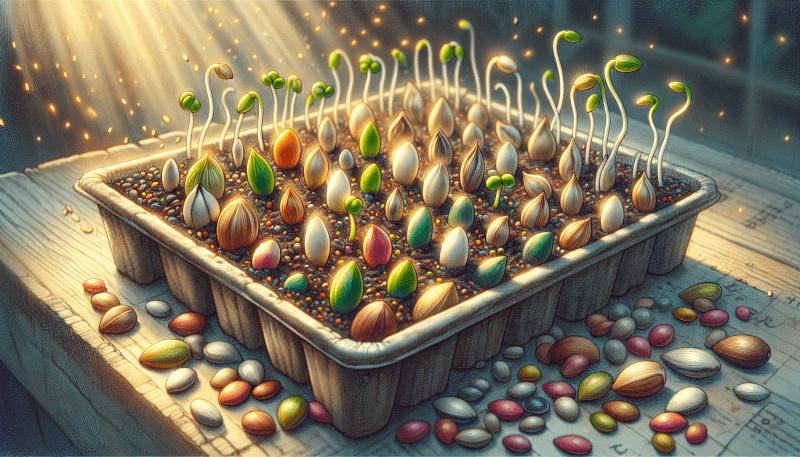Ever wondered how to effortlessly grow sprouts from seeds? Look no further! This article is your ultimate guide to mastering the art of sprout cultivation. Whether you are a seasoned gardener or a novice enthusiast, we’ve got you covered with step-by-step instructions and handy tips to ensure a successful and abundant sprout harvest. From selecting the right seeds to providing optimal growing conditions, discover the secrets to cultivating fresh and nutritious sprouts right in the comfort of your own home. So get ready to embark on a rewarding journey of growing your own sprouts and reaping the benefits of these delightful and nutritious additions to your meals.

Choosing the Right Seeds
When it comes to growing sprouts from seeds, one of the first steps is to choose the right seeds. Researching different sprout varieties is key to finding the ones that suit your preferences and needs. Consider the flavor, texture, and nutritional content of various sprouts to determine which ones you would enjoy the most.
In addition to considering taste and nutrition, it’s important to identify high-quality seeds. Look for reputable seed suppliers or companies that specialize in sprouting seeds. Check for information about the seed’s origin, cultivation methods, and any certifications they may have. High-quality seeds will be free from contaminants and have a higher germination rate, giving you a higher chance of success in sprouting.
Lastly, consider whether you want to opt for organic and non-GMO seeds. Organic seeds are grown without the use of synthetic fertilizers or pesticides, which can be beneficial if you prefer an organic lifestyle or are concerned about potential chemical residues. Non-GMO seeds are not genetically modified, providing a more natural option for sprouting.
Gathering the Necessary Materials
Before you can start growing sprouts, you’ll need to gather the necessary materials. The first item you’ll need is a suitable sprouting container. This can be a tray, a jar, or any container that allows for proper drainage and ventilation. Look for containers specifically designed for sprouting or use household items such as wide-mouth jars with mesh screens or cheesecloth secured over the top.
Next, you’ll need potting soil or seedling mix. Choose a high-quality organic soil or mix designed specifically for seed germination. This type of soil provides the necessary nutrients and moisture retention to support healthy sprout growth.
Having a spray bottle for watering is essential for maintaining the proper moisture levels without overwatering. Look for a spray bottle that can produce a fine mist, allowing you to evenly distribute water over the sprouts.
While not necessary, incorporating organic fertilizer or compost can provide additional nutrients for the sprouts. This can be especially beneficial if you are using soil that doesn’t contain many nutrients. Choose an organic fertilizer or compost that is suitable for seedlings and follow the instructions for proper application.
Preparing the Sprouting Container
Before sowing the seeds, it’s important to prepare the sprouting container properly. Start by cleaning and sterilizing the container to prevent any potential contamination. Wash the container thoroughly with warm soapy water and rinse it well. You can also use a food-grade sanitizer or a weak bleach solution to ensure optimal cleanliness.
If your container doesn’t have drainage holes, consider creating them to prevent waterlogging. Use a drill or a hot nail to make small holes in the bottom of the container. These holes will allow excess water to drain out, preventing root rot and other issues caused by waterlogging.
To catch any water that drains out of the container, place a tray or saucer underneath. This will prevent water from pooling on your countertop or windowsill, keeping your growing area clean and safe.
Soaking the Seeds
Before sowing the seeds, it’s essential to soak them. This process helps to initiate the sprouting process and ensures proper hydration for the seeds. Start by measuring the seeds according to the size of your chosen sprouting container. This will depend on the desired yield and the space available for the sprouts to grow.
Before soaking the seeds, rinse them thoroughly to remove any debris or excess hulls. Place the seeds in a clean container and cover them with water. The water should be at least two to three times the volume of the seeds. Soak the seeds for the recommended time, which can vary depending on the type of seed. Pay attention to any specific instructions provided with the seeds or refer to a sprouting guide.
While soaking, make sure the seeds have sufficient water at all times. This will ensure they can absorb the necessary moisture to begin the sprouting process. Check the water level periodically and add more if needed.
Sowing the Seeds
Once the seeds have soaked for the recommended time, it’s time to sow them. Start by spreading the seeds evenly on the prepared soil or seedling mix. Avoid overcrowding the seeds, as this can impede airflow and increase the risk of fungal growth.
After spreading the seeds, cover them with a thin layer of soil. This will provide some protection and ensure they are in contact with the soil for optimal germination. Lightly press the soil down to ensure good seed-to-soil contact while still allowing for proper ventilation.
Proper ventilation is crucial for sprouts’ growth, as it prevents the buildup of excess moisture and the growth of mold or fungus. Place the container in a well-ventilated area with access to natural light. Avoid placing it in direct sunlight, as this can lead to overheating or drying out of the sprouts.
Sprouting Care and Maintenance
To ensure healthy sprout growth, proper care and maintenance are essential. Misting the sprouts daily with a spray bottle helps to maintain moisture levels without overwatering. Avoid using a strong spray that may damage delicate sprouts. Aim for a fine mist that provides even coverage.
Maintaining proper temperature and humidity is also crucial. Most sprouts prefer a temperature range between 60-70°F (15-21°C). Avoid extreme temperatures, as it can stress the sprouts or inhibit their growth. Use a thermometer to monitor the temperature and make adjustments as needed.
While it’s important to keep the sprouts adequately hydrated, be cautious not to overwater them. Overwatering can lead to root rot and other issues. Monitor the soil moisture regularly and adjust watering accordingly. The soil should be moist, but not soggy.
Monitoring the growth and germination of the sprouts is essential to ensure they are progressing as expected. Look for signs of healthy growth, such as the emergence of tiny leaves or the sprouts reaching the desired height. If you notice any issues, such as yellowing or wilting, it may indicate a problem that needs to be addressed.
Harvesting the Sprouts
Determining the optimal harvest time for sprouts is crucial to enjoy them at their peak flavor and nutrition. Most sprouts are ready to harvest when they have reached a height of 1-3 inches (2.5-7.6 cm) and have developed their first set of true leaves. This is typically around 7-14 days after sowing, depending on the variety.
Before harvesting, ensure your hands are clean and sanitized to prevent any potential contamination. Gently remove the sprouts from the soil, either by cutting them at the base or pulling them out carefully. Avoid damaging the delicate roots or disturbing the soil unnecessarily.
Different sprout varieties may require specific harvesting techniques. For example, if you are growing bean sprouts, you may need to separate the sprouts from the beans themselves. Research the specific guidelines for each sprout variety to ensure proper harvesting and storage.
Storing and Using Sprouts
After harvesting, it’s important to rinse and drain the sprouts thoroughly to remove any remaining soil or debris. Place the sprouts in a clean colander or strainer and rinse them under cool running water. Allow them to drain well to remove excess moisture.
To store the sprouts, place them in a food-grade plastic bag or an airtight container lined with paper towels. This will help absorb any residual moisture and prevent the sprouts from becoming soggy. Store the sprouts in the refrigerator, preferably in the crisper drawer, where the temperature and humidity are more stable.
Proper air circulation is essential to maintaining the quality of the sprouts during storage. If using a plastic bag, gently poke a few small holes in it to allow for airflow. Alternatively, use a container with a breathable lid or leave it slightly ajar to allow for air movement.
Incorporate the sprouts into your meals for added flavor, crunch, and nutrition. Add them to salads, sandwiches, wraps, or stir-fries for a healthy and delicious boost. Experiment with different recipes and flavors to find your favorite ways to incorporate sprouts into your dishes.
Common Sprouting Issues and Troubleshooting
While sprouting is a relatively straightforward process, a few common issues may arise. Mold or fungal growth is often caused by excess moisture or inadequate ventilation. To address this issue, increase ventilation, reduce watering, and ensure the sprouts are not overcrowded.
Yellowing or wilting sprouts may indicate a lack of nutrients or improper watering. Check that the sprouts have access to enough light and adjust the watering schedule or nutrient levels if needed. Provide a balanced and organic fertilizer if your sprouts show signs of nutrient deficiency.
An unpleasant odor coming from sprouts can be an indication of bacterial contamination. This usually occurs when there is poor hygiene or when the sprouts are not properly rinsed and drained. To prevent this issue, wash the sprouts thoroughly and ensure all equipment and containers are clean before use.
Preventing contamination is vital for successful sprouting. Always start with clean hands, wash all equipment and containers thoroughly before use, and practice good hygiene throughout the sprouting process. Regularly sanitize the sprouting container and any tools you use to minimize the risk of contamination.
Expanding Your Sprouting Skills
Once you’ve mastered the basics of sprouting, you may want to expand your skills and try new things. Experiment with different seeds to discover a wide range of flavors and textures. Some popular choices include alfalfa, broccoli, radish, and sunflower sprouts. Be adventurous and explore the vast variety of seeds available for sprouting.
Growing multiple batches simultaneously can help you have a continuous supply of fresh sprouts. Start new batches at staggered intervals to ensure a constant harvest. This way, you’ll always have sprouts available for your meals.
If you’re feeling adventurous, try growing microgreens and baby greens. These tender greens are harvested at a slightly later stage than sprouts and offer more intense flavors and nutritional value. Explore different varieties such as kale, arugula, and spinach to create vibrant and nutritious salads or garnishes.
By following these steps and expanding your sprouting skills, you can enjoy a constant supply of fresh, flavorful, and nutritious sprouts right from your own home. Whether you’re a seasoned gardener or just starting, growing sprouts from seeds is a simple and rewarding way to add a healthy touch to your meals. Happy sprouting!



